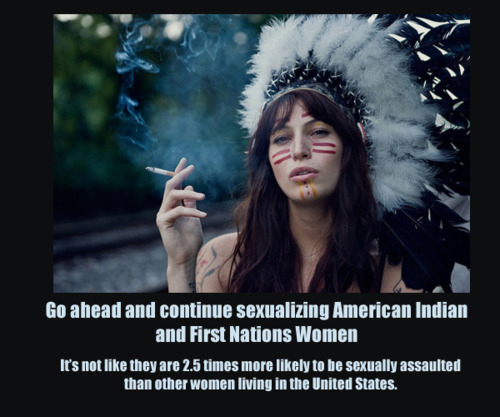Portraying Pocahontas: or the Not-So-Modern Origins of the "Sexy Indian Princess"
She writes of lurid tales of an exotic land spreading throughout Europe within the first few years of Columbus' arrival in the Americas. From the earliest illustrations, America was routinely depicted as a naked Indian woman, a metaphor not lost on the Spanish conquistadors who conquered the “virgin” lands of the New World. Even the English described the Indians in and around the failed Roanoke colony as sweet and welcoming, “devoid of all guile and treason.” (p. 28)
These works inspired hundreds if not thousands of Englishmen to risk their lives and money to journey to this land of “opportunity.” Native women were portrayed as not only accessible but willing. It was seen as practically divine mandate that these Englishmen sow their seed in the new world both literally and figuratively.
As Townsend writes:

"Sexual savages" today
If this stereotypical belief ever abated, it's on the rise once again. With mass-produced outfits and mass-communicated ignorance, hordes of non-Indians are trying to release their "inner Pocahontas." They want to be wild and wanton, or at least convey that impression in a safe way. Why be a plain-vanilla white girl when she can be an exotic Indian princess--a sexual savage who may rip off her buckskins and ravage you at any moment? What red-blooded man wouldn't want a primal playmate like that?
Bury my heart on Halloween
By Sheena Roetman
In fact, current trends in popular culture suggest that the public conscious views Native American culture as something of the past entirely. Scantily-clad pop singers parade around stage donning elaborate war bonnets and glittery face paint and stores such as Urban Outfitters and Forever 21 have encouraged this appropriation by mass-producing cheap replicas of sacred items and pandering the items as elements of costume in everyday dress for everyday people. In reality, objects such as war bonnets and dream catchers, and certain feathers, patterns, and colors, are just as sacred to their respective tribes as the Bible, Koran or Torah is to Christians, Muslims or Jews.
In the contexts of the treatment of Native Americans throughout history and in current media and pop culture, holidays that celebrate colonization and a continued policy of assimilate-or-annihilate tell a very different story than the one taught by public school history textbooks. Objectifying and appropriating cultures and peoples makes it easier for a society to justify certain atrocities committed against those cultures and peoples. Creating a public opinion that centers on the idea that Native Americans are something of the past makes it easier to disregard Natives altogether. Dressing up "Indian" on Halloween may seem relatively innocent, but the very fact that doing so is allowable in our society serves as part of a larger discourse.

"Pop artist Ke$ha regularly wears Native headdresses during performances."
Greenlighting rape and violence
The consequences of this sexualization of Native women are sadly obvious:
Go ahead and continue sexualizing American Indian and First Nations Women
By blackwingeddove
"The fact that Native women are most commonly assaulted by non-Native men is not surprising to me, but does add a historical slant to the idea of how harmful cultural appropriation can be for women. Historically, men have used the implied "natural" sluttiness of women of color as justification for rampant rape or not-really-consensual relationships with women of color, particularly Native women who came into contact with colonists." --Whitney Teal, One Woman's Costume Is Another Woman's Nightmare
Now can you see why my heart breaks and I feel sick every time I see an image of a naked or scantily clad woman in a headdress? This is not just about cultural appropriation. This is about a serious, scary, and continuing legacy of violence against women in Indian Country. These girls probably thought they were just being “counter-culture” or “edgy,” but by perpetuating the stereotypes of Native women as sexual objects, they are aiding and continuing the cycle of violence." --Adrienne Keene, Nudie Neon Indians and the Sexualization of Native Women


1 comment:
And of course there's "Chuluaqui Quodoushka" these days. It was on HBO in 1992. This "Cherokee" sex workshop endorses shota and loli (firewomen? firemen?), in addition to incest and a general sense of hedonism.
They also claim the Cherokee word for penis is tipili (it isn't) because it looks like a tipi (which is not typical of Southeastern cultures at all, and I'd like to see what anatomy textbook they're getting this from).
White people who fetishize Indians fail. At everything.
Post a Comment